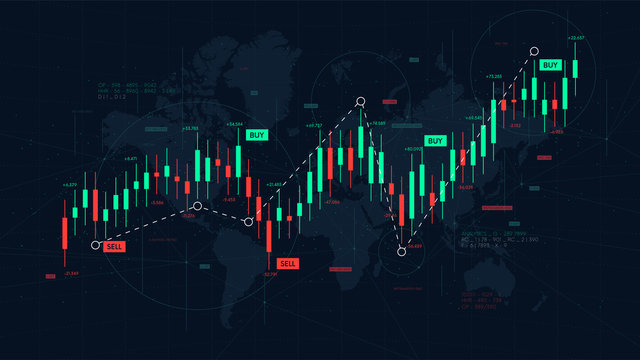Trading is often perceived as a numbers game, where success is determined by complex algorithms, mathematical models, and data analysis. However, seasoned traders know that trading is more than crunching numbers—trading is an art. It requires strategy, discipline, and insight into market behavior. One of the most powerful tools to master this art is candlestick charts. These charts visually represent price movements, helping traders predict trends, spot opportunities, and confidently make smarter trades.

In this article, we’ll explore how trading is an art and how you can master it using candlestick charts. We’ll delve into the psychology of trading, the importance of candlestick patterns, and advanced strategies to elevate your trading game.
Why Trading is an Art
Trading is often compared to art because it requires creativity, intuition, and emotional control. Just as an artist uses brushes and colors to create a masterpiece, a trader uses tools like candlestick charts, technical indicators, and market analysis to navigate the financial markets.
The Role of Psychology in Trading
Trading psychology plays a crucial role in determining success. Fear, greed, and overconfidence can cloud judgment and lead to poor decisions. Mastering the art of trading involves understanding your emotions and maintaining discipline. For a deeper dive into this topic, check out this comprehensive guide on Trading Psychology: The Key to Successful Trading.
The Importance of Discipline and Patience
Discipline and patience are the cornerstones of successful trading. A trader must stick to their strategy, avoid impulsive decisions, and wait for the right opportunities. This is where candlestick charts come into play—they provide clear signals and help traders stay focused on their goals.
Candlestick Charts: Your Secret Weapon
Candlestick charts originated in Japan over 300 years ago and have since become a staple in technical analysis. These charts provide a visual representation of price movements, making it easier to identify patterns and trends.
How Candlesticks Work
Each candlestick represents a specific period (e.g., 1 minute, 1 hour, 1 day) and displays four key pieces of information:
- Open Price: The price at the beginning of the period.
- Close Price: The price at the end of the period.
- High Price: The highest price during the period.
- Low Price: The lowest price during the period.
The candlestick’s body represents the range between the open and closed prices, while the wicks (or shadows) show the high and low prices.
Why Candlesticks Are Effective
Candlestick charts are highly effective because they provide a clear and concise view of market sentiment. By analyzing the patterns formed by these candlesticks, traders can predict potential price movements and make informed decisions.
For a detailed guide on candlestick patterns and their significance, visit Candlestick Pattern Analysis.
Mastering Candlestick Patterns
Candlestick patterns are the building blocks of technical analysis. These patterns provide insights into market behavior and help traders predict future price movements. By understanding these patterns, traders can identify potential reversals, continuations, and market trends. Candlestick patterns are not just about recognizing shapes on a chart; they are about interpreting the psychology of market participants. Each pattern tells a story of the battle between buyers and sellers, offering clues about who is gaining control.
Here are some of the most common candlestick patterns and their significance:
1. Bullish Engulfing Pattern
The bullish engulfing pattern is a strong reversal signal that occurs during a downtrend. It consists of two candles: a small bearish candle followed by a larger bullish candle that completely engulfs the body of the previous candle. This pattern indicates that buyers have overwhelmed sellers, potentially leading to a trend reversal. Traders often look for this pattern at key support levels to confirm a potential upward move.
2. Bearish Engulfing Pattern
The bearish engulfing pattern is the opposite of the bullish engulfing pattern. It occurs during an uptrend and consists of a small bullish candle followed by a larger bearish candle that engulfs the previous candle. This pattern suggests that sellers have taken control, signaling a potential reversal from an uptrend to a downtrend. It is often used to identify exit points or to initiate short positions.
3. Doji
A Doji is a unique candlestick pattern characterized by a very small body, indicating that the open and close prices are nearly equal. This pattern reflects indecision in the market, as neither buyers nor sellers could gain control. Depending on the context, a Doji can signal a potential reversal or continuation. For example, a Doji after a prolonged uptrend may indicate that the trend is losing momentum, while a Doji during a consolidation phase may suggest that the market is preparing for a breakout.
4. Hammer and Hanging Man
The hammer and hanging man are single-candle patterns that have small bodies and long lower wicks. The hammer appears during a downtrend and signals a potential reversal, as it indicates that sellers pushed the price lower, but buyers managed to regain control by the close. The hanging man, on the other hand, appears during an uptrend and suggests a potential downturn. It shows that buyers are losing strength, and sellers may soon take over.
For a more comprehensive list of candlestick patterns and their applications, check out Candlesticks in Stock Market.
Advanced Strategies for Mastering Trading
While candlestick patterns are powerful on their own, combining them with advanced technical indicators can significantly enhance your trading strategy. These tools provide additional confirmation and help traders make more informed decisions.
1. Moving Averages
Moving averages are one of the most widely used technical indicators. They smooth out price data to identify trends and provide dynamic support and resistance levels. By combining candlestick patterns with moving averages, traders can confirm trends and improve the accuracy of their trades. For example, a bullish engulfing pattern near a rising 50-day moving average may provide a strong buy signal, as it indicates both a reversal and a supportive trend.
2. Relative Strength Index (RSI)
The RSI is a momentum oscillator that measures the speed and change of price movements. It ranges from 0 to 100 and is used to identify overbought or oversold conditions. When combined with candlestick patterns, the RSI can provide additional confirmation for potential reversals. For instance, a bearish engulfing pattern accompanied by an RSI reading above 70 (overbought) may signal a strong sell opportunity.
3. Bollinger Bands
Bollinger Bands consist of a moving average and two standard deviations above and below it. They help identify volatility and potential breakout points. When the price touches the upper band, it may indicate overbought conditions, while touching the lower band may suggest oversold conditions. Candlestick patterns that form near these bands can provide valuable insights. For example, a hammer near the lower Bollinger Band may signal a potential reversal and a buying opportunity.
For a detailed guide on advanced technical indicators, visit Advanced Technical Indicators: A Comprehensive Guide.
The Psychology Behind Candlestick Patterns
Understanding candlestick patterns goes beyond recognizing shapes on a chart; it involves interpreting the psychology of market participants. Each pattern reflects the emotions and actions of buyers and sellers, providing insights into market sentiment.
For example, a bullish engulfing pattern shows that buyers have gained confidence and are willing to push prices higher, while a bearish engulfing pattern indicates that sellers are taking control. Similarly, a Doji reflects indecision, suggesting that the market may be at a turning point.
By mastering the psychology behind these patterns, traders can anticipate market movements and make better trading decisions. For a deeper understanding of trading psychology, explore Trading Psychology: The Key to Successful Trading.
Practical Tips for Using Candlestick Patterns
- Combine Patterns with Other Tools: Candlestick patterns are most effective when used in conjunction with other technical indicators, such as moving averages, RSI, and Bollinger Bands.
- Focus on Key Levels: Look for candlestick patterns near significant support and resistance levels, as they provide stronger signals.
- Practice Patience: Not every pattern will result in a successful trade. Wait for confirmation before entering a position.
- Backtest Your Strategy: Test your candlestick-based strategy on historical data to evaluate its effectiveness.
- Manage Risk: Always use stop-loss orders to limit potential losses and protect your capital.
The Role of Candlesticks in Stock Market Trading
Candlesticks are particularly useful in stock market trading because they provide real-time insights into price movements. Whether you’re trading stocks, forex, or commodities, candlestick charts can help you make informed decisions.
Benefits of Using Candlesticks in Stock Trading
- Visual Clarity: Candlestick charts are easy to read and interpret.
- Pattern Recognition: They help identify recurring patterns that signal potential price movements.
- Market Sentiment: Candlesticks provide insights into buyer and seller behavior.
To learn more about how candlesticks are used in stock market trading, visit Candlesticks in Stock Market.
Conclusion: Master Trading with Candlesticks
Trading is indeed an art, and mastering it requires a combination of skill, discipline, and the right tools. Candlestick charts are one of the most powerful tools at your disposal, providing valuable insights into market behavior and helping you make smarter trades.
By understanding candlestick patterns, combining them with advanced technical indicators, and mastering the psychology of trading, you can elevate your trading game and achieve consistent success.

